Choosing Ideal Colors for Your New Home
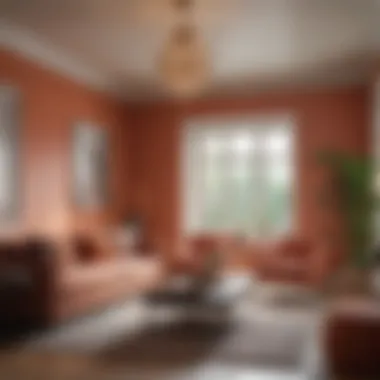
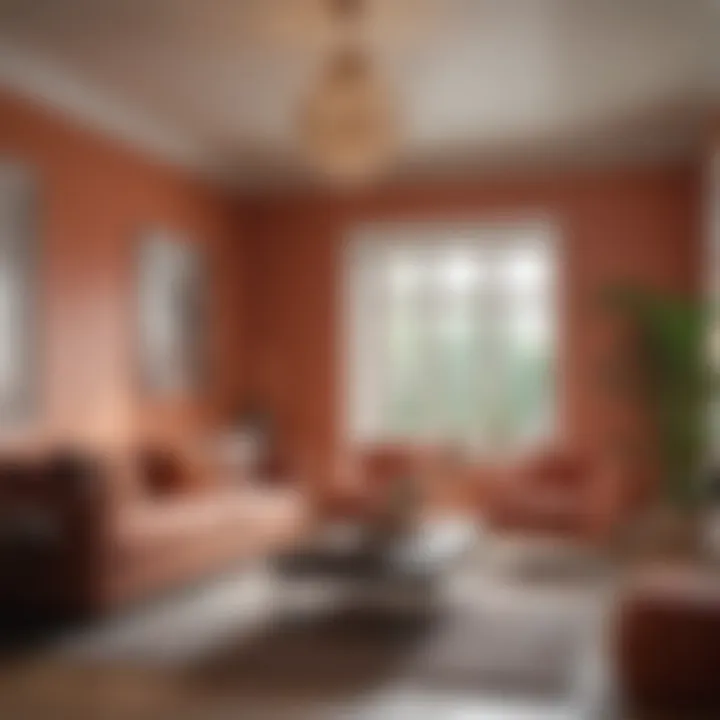
Intro
Selecting the right colors for your new home is critical. Color influences mood, perception, and ambiance. An optimal palette can transform a space, making it feel more inviting, spacious, or calm. This guide aims to equip homeowners and design enthusiasts with knowledge about color psychology, trending styles, and practical tips to enhance their living environment.
Design Inspiration
Designing a new home begins with inspiration. The colors chosen set the tone for every room, affecting both aesthetics and functionality. Knowing what is trending and understanding color palettes can guide homeowners toward informed decisions.
Trending Styles
Color trends are ever-evolving. One current trend is the use of earthy tones. Shades like terracotta, olive green, and sandy beige can create a warm and inviting atmosphere. These colors offer a connection to nature, making spaces feel grounded. Another trend is the bold use of navy and deep jewel tones. These colors can add sophistication and drama, especially in areas like dining rooms or home offices.
Some additional styles to consider include:
- Minimalist Neutrals: Soft grays and whites create an airy feel.
- Pastel Colors: Light hues like blush and mint can add a gentle touch.
- Textured Colors: Adding different textures like matte or glossy finishes can enhance visual interest.
Color Palettes
A well-thought-out color palette plays a significant role in creating harmony between different rooms. Key color schemes to consider include:
- Monochromatic: Different shades of one color for a cohesive look.
- Analogous: Colors next to each other on the color wheel to create a serene feel.
- Complementary: Utilizing colors across from each other on the wheel for contrast and impact.
When choosing a palette, think about how colors interact under various lighting conditions. Natural light can lighten hues, while artificial lighting may intensify them.
Practical Tips
Understanding practical aspects of color selection can save both time and money. Homeowners often overlook maintenance and budgeting when planning.
Maintenance & Care
Some colors and finishes are easier to maintain than others. For instance, light colors may show dirt and stains more readily, requiring more frequent cleaning. In high-traffic areas, consider durable paints or finishes designed to withstand wear. Waterproof or washable options can greatly aid in keeping surfaces clean.
Budgeting & Planning
Budgeting for paint and materials depends on the scale of your project. It is wise to allocate funds for both quality supplies and professional assistance if needed. Remember that color selection is not solely about the paint; flooring, fabrics, and other decor elements also contribute to the overall scheme.
Key Budgeting Steps:
- Set a budget: Determine how much to invest in color and decor.
- Prioritize areas: Focus on high-impact rooms first.
- Get samples: Test colors in your space before committing.
"Color is a power which directly influences the soul." - Wassily Kandinsky
Understanding Color Theory
Understanding color theory is a foundational element in the process of selecting the right colors for new homes. It provides insight into how colors interact, influence perceptions, and evoke emotional responses. Having a solid grasp of color theory allows homeowners and designers to make informed decisions that enhance the overall aesthetic of living spaces while aligning with personal tastes.
Color theory is not just about choosing a color and applying it to a wall. It involves understanding the relationships between colors and how they can work together harmoniously. This knowledge is crucial for anyone looking to create environments that feel cohesive, inviting, and visually appealing.
Recognizing the basics of color theory can lead to significant benefits. A well-thought-out color palette can transform a bland space into one that feels vibrant and alive. Moreover, it can help in creating specific moods or atmospheres that enhance the functionality of each room, whether it be energizing a kitchen or promoting relaxation in a bedroom.
Key aspects of color theory include the color wheel, color harmonies, and the psychological effects of colors. All these elements are interlinked, influencing how colors can be used strategically across different spaces in the home. As such, understanding color theory is essential for anyone involved in home design, whether experienced or a novice.
The Basics of Color Theory
At the core of color theory is the color wheel. This visual representation includes primary colors, secondary colors, and tertiary colors. Understanding this wheel is step one:
- Primary colors (Red, Blue, Yellow) are the building blocks.
- Secondary colors (Green, Orange, Purple) result from mixing primary colors.
- Tertiary colors are formed from a combining primary and secondary colors.
Each color possesses its unique qualities and can invoke different feelings. For example, blue is often associated with calmness, while yellow can evoke happiness. In practice, the colors chosen for walls, furniture, and decor can greatly influence how a space is perceived by its inhabitants and visitors.
Color Harmonies and Their Importance
Color harmony refers to the arrangement of colors that are pleasing to the eye. There are several types of color harmonies including:
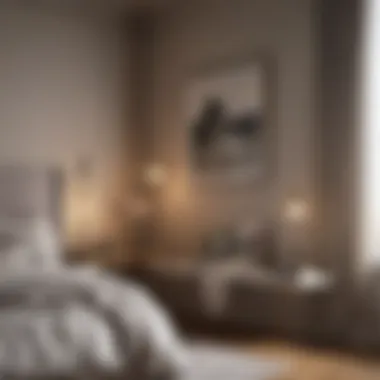

- Complementary colors: Colors opposite each other on the color wheel, creating high contrast.
- Analogous colors: Colors that sit next to each other on the wheel, providing a serene look.
- Triadic colors: Three evenly spaced colors on the wheel, offering vibrancy and balance.
The importance of these harmonies lies in their ability to guide homeowners in creating balanced and aesthetically pleasing spaces. A space that utilizes color harmonies will naturally feel more cohesive and thought out, providing comfort to those who inhabit it.
The Emotional Impact of Colors
Colors have direct emotional impacts on individuals. It is well-documented that certain colors evoke specific feelings and behaviors. For instance:
- Red can stimulate the senses and increase energy.
- Green promotes relaxation and peace, often associated with nature.
- Purple can invoke feelings of creativity and luxury.
Homeowners should consider these emotional impacts when selecting colors for each area of their home. The choice of color can affect mood, perceptions of space, and overall experiences within those spaces. Making color choices based on their emotional implications can contribute to a more inviting and harmonious home environment.
"Color is the keyboard, the eyes are the harmonies, the soul is the piano with many strings." - Wassily Kandinsky
In summary, understanding color theory equips homeowners with tools to make thoughtful choices in their interior spaces. This understanding encompasses the basics of color interaction, harmonies that bring aesthetic pleasure, and the emotional responses colors can elicit. Knowing how to apply these principles effectively can elevate the design of any new home.
Current Color Trends
Color selection in home design is not just a matter of personal taste but also involves understanding current color trends. These trends help define an aesthetic that resonates with homeowners and provides a backdrop for their lives. The significance of these trends lies in their ability to reflect changing cultural moods and preferences, offering valuable insight into the evolving landscape of interior design. Being aware of what is trending can enhance the visual appeal of a home, making it inviting and contemporary.
Popular Color Palettes for Homes
When it comes to color palettes, several combinations have gained popularity among homeowners in recent years. Neutral tones such as beige, taupe, and soft gray continue to dominate, providing a warm and calming backdrop. These shades work well with various decor styles and encourage a sense of spaciousness.
In addition to neutrals, earthy tones like sage green, terracotta, and muted blues have gained traction. These colors connect interior spaces with nature, promoting tranquility and warmth. Homeowners can utilize these palettes in a variety of ways, such as in accent walls or throughout an entire room, ensuring that their selections are visually cohesive.
Emerging Trends in Color Applications
As technology advances, designers are exploring innovative color applications that go beyond traditional paint use. For instance, enhanced color change technology allows homeowners to adjust the shade of their walls depending on the time of day or mood. This creates dynamic environments that adapt to their inhabitants.
Moreover, rich hues like deep navy, emerald green, and burnt orange have emerged, with homeowners increasingly embracing bold colors. These shades can serve as statement pieces in furniture or decor items, enriching an otherwise neutral space without overwhelming it.
Timeless vs. Trendy Colors
When making color choices, homeowners must balance between timeless and trendy colors. Timeless colors, such as white, charcoal, and muted pastels, maintain their appeal over time. They provide a reliable foundation for any decorating style and can be easily updated with accessories and accents.
In contrast, trendy colors reflect the spirit of the times but can fall out of favor quickly. Rocking a trendy shade is enticing, yet it may require more frequent updates to stay relevant. Therefore, it is recommended to use trendy colors sparingly, as accents in art or furnishings, supporting the base of timeless hues.
Choosing the right color can enhance the home environment, making it a reflection of personal style while also aligning with prevailing trends.
In summary, understanding current color trends is essential for creating a home that feels both modern and inviting. Homeowners should consider popular palettes, emerging techniques, and the dynamic between timeless and trendy hues in their design decisions.
Selecting the Right Color for Each Room
Choosing the right colors for each room in a home is vital to creating a cohesive and inviting atmosphere. Each space serves a distinct purpose and can benefit from a color scheme that enhances its functionality and feel. Selecting a color that complements the room's use helps in amplifying the overall aesthetic. This approach not only reflects personal taste but also contributes to a more enjoyable living experience.
Living Rooms: A Blend of Comfort and Style
The living room is often seen as the heart of the home. It is the space where family gathers and entertaining occurs. The color scheme here should strike a balance between comfort and style. Warm neutrals like beige or soft taupe can provide a welcoming backdrop while allowing for playful accents in furniture or decor.
Consider accent walls or furniture in deeper colors like navy or emerald green. These tones can add depth and sophistication. Additionally, the use of soft whites or pale blues can create an airy and open feel. Ensure you consider the natural lighting. A bright room can handle darker shades well, while a dimly lit room may benefit from lighter colors to enhance brightness.
Bedrooms: Creating a Peaceful Oasis
In the bedroom, selecting a color that promotes tranquility is essential. Soft pastels or muted tones such as lavender and powder blue encourage relaxation. They create a serene environment, conducive to sleep. Avoid overly vibrant colors, which can cause overstimulation.
Accent colors can be strategically placed in linens or artwork to maintain a cohesive feel. Using shades of green, inspired by nature, can also invoke a sense of calm. Along with color, it’s important to factor in lighting. Warm white lights can enhance the soothing aura of your chosen palette.
Kitchens: Energizing and Inviting Spaces
Kitchens should feel energizing yet inviting. Bright whites and soft yellows can create a cheerful atmosphere that promotes activity. Consider incorporating bold splashes of color in cabinetry or backsplash, using colors like teal or cherry red. These can stimulate appetite and conversation.
Open floor plans can benefit from color continuity, tying the kitchen with adjacent areas. Instead of disconnected spaces, this approach fosters an inviting flow. Soft grays can ground the palette while still allowing brighter elements to shine.
Bathrooms: A Refreshing and Relaxing Retreat
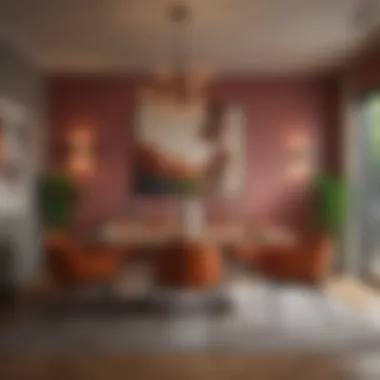
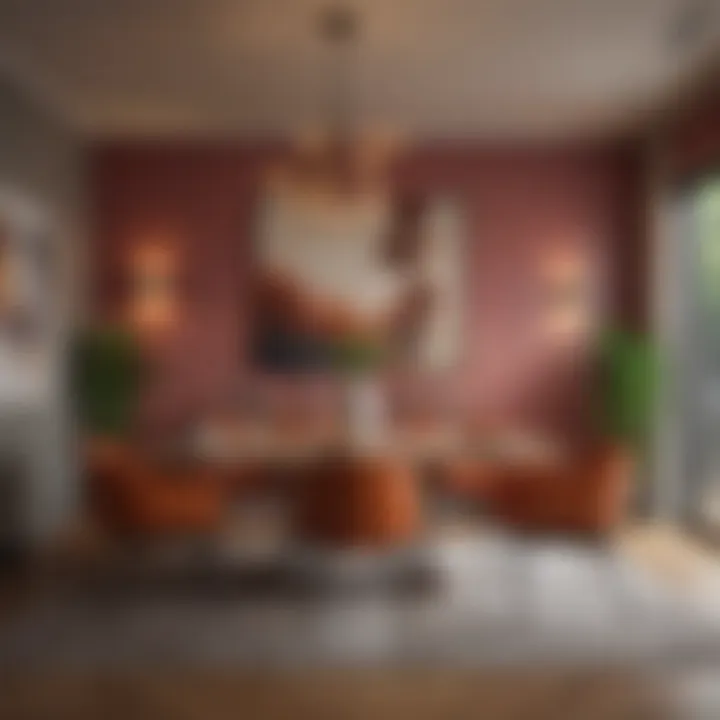
For bathrooms, cool colors are often preferable. Soft blues, greens, or even pale grays can evoke the fresh feeling of water and cleanliness. These shades create a spa-like atmosphere that encourages relaxation.
Additionally, incorporating white elements can enhance the feeling of cleanliness. Bold accents in towels or décor can add personality without overwhelming the space. It’s also crucial to consider the size of the bathroom. Smaller spaces may look larger with lighter shades, while larger bathrooms can embrace deeper tones without feeling closed in.
Carefully selecting color not only enhances aesthetics but also reflects individual style and the intended use of each room.
Testing Colors Before Committing
When embarking on the journey of selecting colors for new homes, the act of testing is essential. Homeowners often make decisions based on digital samples or memories of colors in other places. However, colors can transform drastically based on various aspects, namely lighting, surrounding elements, and personal perception. Testing colors before finalizing them ensures a more accurate alignment with the intended atmosphere and aesthetic.
The Importance of Light in Color Perception
Light holds a vital role in how we perceive color. The spectrum of natural light changes throughout the day, resulting in different hues and intensities. Morning light is often cooler, while evening light leans warmer. This can shift how a color appears on your walls. For instance, a soft blue may appear soothing in the morning light but can look entirely different as the day progresses.
"Understanding light allows homeowners to better predict how a shade will change under various conditions."
When testing colors, it is advisable to observe them at different times of the day. This practice can reveal subtle variations that may not be evident when only viewed under artificial lighting. Pay attention to the orientation of the room. North-facing rooms can give cooler tones, while south-facing spaces embrace warmth. Knowing this aids in choosing colors that remain consistent and true to form within the home environment.
Using Samples and Swatches Effectively
Choosing paint color requires a practical approach. Using smaller samples or swatches can save time, money, and disappointment. Here are some beneficial strategies in utilizing samples and swatches effectively:
- Obtain sample pots: Purchase small quantities of your preferred paint colors. This allows for testing on actual surfaces rather than just relying on a tiny chip.
- Paint large patches: Apply the sample paint on a sizeable area of the wall. Small patches might not reveal the total color impact.
- Observe under various lighting: As previously mentioned, check the swatches under different conditions. This includes both natural and artificial light.
By taking these steps, homeowners can understand how a color behaves before making a broader application—a clear route to more informed decisions.
Visualizing Colors in Context
Context is important when considering colors for a new home. A room's existing features and furnishings will interact with the new color choices. Visualizing how colors work with furniture, artwork, and architectural elements fosters a cohesive look.
- Create mood boards: Collect images that resonate with the new color theme. This exercise helps visualize the color in relation to your design goals.
- Digital tools and apps: Many technology tools provide augmented reality solutions to see colors in situ. This can aid in visualizing the whole space effectively.
- Consider future changes: Think about how your color selection will harmonize with potential changes in furniture or decor over time.
Integrating Colors with Design Elements
Integrating colors with design elements is a critical step in the home design process. Choices made in this area significantly affect the overall atmosphere and mood of living spaces. The synergy between colors, furniture, accessories, and design features culminates in a well-rounded aesthetic. When done effectively, it enhances coherence and unity throughout the home, thereby contributing to a more harmonious environment.
Color Coordination with Furniture and Accessories
Furniture and accessories serve as integral components of any room. Their color, texture, and form provide substantial opportunities for personal expression. It's essential to consider how the colors of these elements align with the overall color palette of a space. Choosing hues that complement existing colors instills a sense of balance. One method is to apply a monochromatic scheme, where variations of the same color create visual interest while maintaining cohesiveness. Alternatively, using contrasting colors can add excitement and drama to a room, but it requires careful selection to avoid chaos.
- Consider the Function: For instance, vibrant colors can encourage conversation in living rooms or lively gatherings. Softer tones might be more suited for bedrooms to promote relaxation.
- Assess the Scale: Larger furniture pieces demand attention; therefore, they should harmonize with the wall colors. Accessories, being smaller, can either match or provide contrast.
The Role of Textures and Patterns
Textures and patterns add a layer of dimension and richness to home design. A well-thought-out blend of textures can enhance the visual experience of a space. Combining smooth, shiny surfaces with rough materials can create a striking effect. Moreover, patterns can introduce variety while reinforcing a color scheme.
- Layering is Key: Use different textures within the same color family to introduce depth. For example, a soft velvet sofa combined with woven cushions retains a unified look while preventing monotony.
- Play with Patterns: Use patterned items like curtains or rugs to tie together various colors found in furniture or wallpaper. Stripes, florals, or geometric patterns can add character to your design.
Creating Focal Points and Flow
Establishing focal points is vital in guiding the viewer’s eye and creating flow in home design. A focal point can be an accent wall, a piece of artwork, or even a standout piece of furniture. Colors are fundamental in defining these points. Choosing a bold color for these elements can effectively draw attention and create interest.
- Strategic Placement: Position larger, bolder colors at strategic points in a room, such as the back wall or a significant piece of furniture. This draws attention and sets the stage for surrounding elements.
- Flow Between Rooms: Ensure a smooth transition when moving from one room to another. Consistent color usage creates a sense of continuity. For instance, if the living room features navy blue accents, using a lighter blue in adjacent areas can maintain the flow.
"The integration of color and design elements not only enhances visual appeal but also reflects individual style and taste."
Effective integration of colors with design elements fosters a cohesive, inviting atmosphere in your home. By carefully considering how these aspects interact, homeowners can curate spaces that not only look appealing but also feel comfortable and harmonious.
Sustainable and Eco-friendly Color Choices
In contemporary design, the selection of colors extends beyond aesthetics. Sustainable and eco-friendly color choices are increasingly significant in shaping a conscious living environment. As homeowners become more aware of environmental issues, the impact of color selections on health and the planet has gained prominence. Choosing sustainable options can reduce exposure to harmful chemicals, improve indoor air quality, and exhibit responsibility towards the ecosystem. These choices often translate to the use of materials and products that are less harmful and more sustainable.
Adopting eco-aware colors also aligns with broader trends in sustainable design. Reflecting on the interconnectedness of choices allows for the creation of beauty that respects both personal well-being and the environment. Homeowners have the potential to make choices that resonate with their values while still providing a visually appealing atmosphere.


Understanding Non-toxic Paint Options
Navigating the paint aisle may seem straightforward, yet the options are myriad. Non-toxic paints are essential for promoting a healthier living space. They typically avoid harmful chemicals found in many traditional paints, such as volatile organic compounds (VOCs).
VOCs can evaporate into the air, potentially leading to health problems. Homeowners should seek paints labeled as low-VOC or zero-VOC. Natural paint brands like Benjamin Moore and Behr provide options that prioritize safety. Additionally, using organic and plant-based pigments supports eco-friendly practices. It is also imperative to check for certifications such as Green Seal or the Environmental Protection Agency's Safer Choice label.
Choosing Colors that Harmonize with Nature
Selecting colors inspired by nature can enhance a home's ambiance while promoting a sense of tranquility. Greens and blues can reflect natural landscapes, offering an outdoor connection indoors. Earth tones, such as terracotta or soft browns, create a grounded atmosphere, echoing the materials found in nature.
Homeowners can draw inspiration from their surroundings. Observing local flora can guide the choice of color palettes that feel harmonious and connected to the environment.
- Incorporate these colors:
- Leafy Greens: Evokes tranquility and growth.
- Oceanic Blues: Imbues calmness and serenity.
- Warm Earth Tones: Brings warmth and natural vibes into the home.
Moreover, combining natural colors with eco-friendly materials reinforces a commitment to sustainability while enriching the home's aesthetic. Overall, sustainable and eco-friendly color choices not only uplift the space aesthetically but also safeguard the health of the inhabitants and the planet.
"By choosing eco-friendly colors, you promote a harmonious living space that values both beauty and environmental responsibility."
Deliberate color choice plays a critical role in establishing homes that reflect both personal values and commitment to sustainability.
The Psychology of Color in Home Design
Color plays a fundamental role in home design. Understanding the psychology of color is essential for homeowners looking to create spaces that reflect their personal taste and aspirations. Colors do not merely serve an aesthetic function; they actively influence emotions, behavior, and the overall ambiance of a living space. In this section, we will explore how the right color choices can enhance moods, foster a sense of belonging, and connect with cultural significances.
How Color Affects Mood and Behavior
Different colors evoke varying emotional responses. For example, soft blues often promote tranquility, while bright yellows can spark energy and joy. Studies show that colors can affect physiological responses, like heart rate and blood pressure. This is important when selecting palettes for specific rooms.
- Living Rooms: Choosing a warm beige or a soft green can make these spaces feel more welcoming and comfortable.
- Kitchens: Bright colors like red or orange can stimulate appetite and social interaction, making them ideal for cooking and gathering.
- Bedrooms: Soft pastels or muted tones create a serene environment conducive to rest.
Colors can also impact productivity. For instance, blue is often linked to effective problem-solving and concentration. Home offices painted in this shade may enhance focus, while a more complex combination might serve as an inspiring backdrop for creativity.
"Color is the keyboard, the eyes are the harmonies, the soul is the piano with many strings." - Wassily Kandinsky
Color Associations and Cultural Perspectives
Colors carry distinctive meanings across different cultures. For instance, in Western societies, white is often associated with purity and new beginnings, making it a common choice for new homeowners. Conversely, in some Eastern cultures, white may signify mourning. Thus, it is crucial to consider the cultural implications of color choices.
Different colors also resonate differently based on personal experiences and backgrounds. For example:
- Red: Can symbolize love and warmth in some cultures but hold connotations of danger or caution in others.
- Green: Generally relates to nature and growth but may have various cultural meanings related to prosperity or fertility.
Understanding these associations can guide homeowners in making choices that resonate positively with themselves and with their guests. Researching cultural significance helps ensure that the colors selected align with the intended emotional response and cultural context.
In summary, the psychology of color is a complex field that requires thoughtful consideration. Homeowners should take time to explore colors not just for their visual appeal but also for their potential impact on mood and behavior. By making informed choices, homeowners can create harmonious spaces that not only look good but also feel good.
The Future of Color in Home Design
The landscape of home design is constantly evolving. In this context, the future of color selection holds enormous significance. Understanding upcoming trends can help homeowners and designers make informed choices that not only reflect their personal style but also incorporate broader societal influences. The future of color in home design will likely blend innovation, sustainability, and psychological insight into the decision-making process.
As environmental consciousness rises, the importance of selecting colors that align with sustainable practices will further shape design choices. Homeowners are increasingly interested in how colors can work with the environment. This includes understanding how shades and tones can create a lasting impact on the psyche and well-being of residents. Thus, future color selections will be informed by both emotional resonance and environmental responsibility.
"Color is a power which directly influences the soul." - Wassily Kandinsky
Innovative Techniques and Materials
The advancements in paint technology have opened new doors for innovative applications. Homeowners can now choose materials that are non-toxic and eco-friendly. Paints made from natural clays or plant-based pigments offer stunning hues without harmful chemicals. This shift towards sustainable options is crucial as we become more mindful of our health and environment.
Additionally, digital tools allow for unprecedented visualization. Homeowners can use augmented reality to see how a specific color would look in their space before making any commitments. This capability enhances the decision-making process, providing clarity that traditional swatches cannot. Ultimately, these techniques enable an easier and more informed approach to color selection.
With innovative materials, colors can also have improved durability. Some paints now incorporate technology that allows for self-cleaning surfaces or finishes that are resistant to wear and tear. This practicality means homeowners can enjoy their color choices for longer without constant maintenance.
Predictions for Evolving Color Trends
As we look ahead, several trends are likely to shape the future of color in home design.
- Nature-inspired Palettes: Expect to see a rise in shades that reflect the natural world, such as earthy greens, soft browns, and serene blues. These colors can create a calming environment that fosters well-being and connection to nature.
- Bold Accents: Alongside softer hues, vibrant accent colors are predicted to make a comeback. This choice allows homeowners to express individuality while keeping some areas neutral. For example, a bold orange or deep navy could serve as a striking focal point in a predominantly light-colored room.
- Mindful Melange: A blending of colors will gain traction. Combining muted shades with brighter tones adds depth and character to spaces. Rather than stark contrasts, a thoughtful mix can create harmony that feels curated rather than chaotic.
In summary, the future of color in home design promises to be both innovative and deeply connected to the world around us. Homeowners, designers, and enthusiasts must stay informed about these evolving trends and techniques. Recognizing the interplay between color, psychology, and sustainability will ensure choices resonate well into the future.















